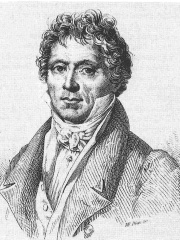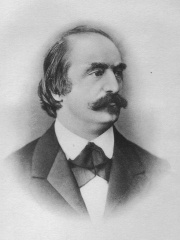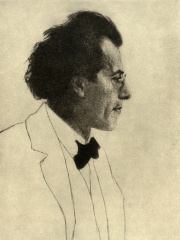
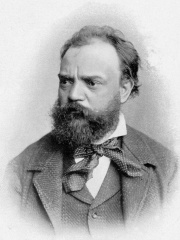
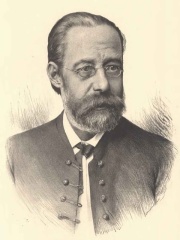
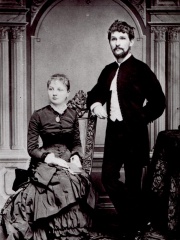
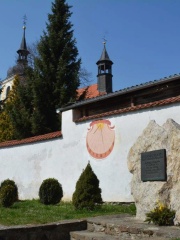
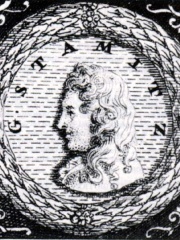
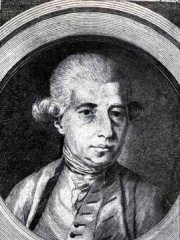
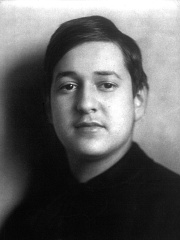
The Most Famous
COMPOSERS from Czechia
Top 10
The following people are considered by Pantheon to be the top 10 most legendary Czech Composers of all time. This list of famous Czech Composers is sorted by HPI (Historical Popularity Index), a metric that aggregates information on a biography's online popularity. Visit the rankings page to view the entire list of Czech Composers.

1. Gustav Mahler (1860 - 1911)
With an HPI of 87.34, Gustav Mahler is the most famous Czech Composer. His biography has been translated into 122 different languages on wikipedia.
Gustav Mahler (German: [ˈɡʊstaf ˈmaːlɐ] ; 7 July 1860 – 18 May 1911) was an Austro-Bohemian Romantic composer, and one of the leading conductors of his generation. As a composer he acted as a bridge between the 19th-century Austro-German tradition and the modernism of the early 20th century. While in his lifetime his status as a conductor was established beyond question, his own music gained wide popularity only after periods of relative neglect, which included a ban on its performance in much of Europe during the Nazi era. After 1945 his compositions were rediscovered by a new generation of listeners; Mahler then became one of the most frequently performed and recorded of all composers, a position he has sustained into the 21st century. Born in Bohemia (then part of the Austrian Empire) to Jewish parents of humble origins, the German-speaking Mahler displayed his musical gifts at an early age. After graduating from the Vienna Conservatory in 1878, he held a succession of conducting posts of rising importance in the opera houses of Europe, culminating in his appointment in 1897 as director of the Vienna Court Opera (Hofoper). During his ten years in Vienna, Mahler—who had converted to Catholicism to secure the post—experienced regular opposition and hostility from the anti-Semitic press. Nevertheless, his innovative productions and insistence on the highest performance standards ensured his reputation as one of the greatest of opera conductors, particularly as an interpreter of the stage works of Wagner, Mozart, and Tchaikovsky. Late in his life he was briefly director of New York's Metropolitan Opera and the New York Philharmonic. Mahler's œuvre is relatively limited; for much of his life composing was necessarily a part-time activity while he earned his living as a conductor. Aside from early works such as a movement from a piano quartet composed when he was a student in Vienna, Mahler's works are generally designed for large orchestral forces, symphonic choruses and operatic soloists. These works were frequently controversial when first performed, and several were slow to receive critical and popular approval; exceptions included his Second Symphony, and the triumphant premiere of his Eighth Symphony in 1910. Some of Mahler's immediate musical successors included the composers of the Second Viennese School, notably Arnold Schoenberg, Alban Berg and Anton Webern. Dmitri Shostakovich and Benjamin Britten are among later 20th-century composers who admired and were influenced by Mahler. The International Gustav Mahler Society was established in 1955 to honour the composer's life and achievements.

2. Antonín Dvořák (1841 - 1904)
With an HPI of 85.64, Antonín Dvořák is the 2nd most famous Czech Composer. His biography has been translated into 128 different languages.
Antonín Leopold Dvořák ( d(ə-)VOR-zha(h)k; Czech: [ˈantoɲiːn ˈlɛopold ˈdvor̝aːk] ; 8 September 1841 – 1 May 1904) was a Czech composer. He frequently employed rhythms and other aspects of the folk music of Moravia and his native Bohemia, following the Romantic era nationalist example of his predecessor Bedřich Smetana. Dvořák's style has been described as "the fullest recreation of a national idiom with that of the symphonic tradition, absorbing folk influences and finding effective ways of using them", and Dvořák has been described as "arguably the most versatile... composer of his time". Dvořák displayed his musical gifts at an early age, being a talented violin student. The first public performances of his works were in Prague in 1872 and, with special success, in 1873, when he was 31 years old. Seeking recognition beyond the Prague area, he submitted scores of works including symphonies to competitions in Germany and Austria. He did not win a prize until 1874, with Johannes Brahms on the jury of the Austrian State Competition. In 1877, after his third win, Brahms recommended Dvořák to his publisher, Simrock, who commissioned what became the Slavonic Dances, Op. 46. The sheet music's high sales and critical reception led to his international success. A London performance of Dvořák's Stabat Mater in 1883 led to many other performances in the United Kingdom, the United States, and eventually Russia in March 1890. The Seventh Symphony was written for London in 1885. In 1892, Dvořák became the director of the National Conservatory of Music of America in New York City. While in the United States, Dvořák wrote his two most successful orchestral works: the Symphony From the New World, which spread his reputation worldwide, and his Cello Concerto, one of the most highly regarded of all cello concerti. On a summer holiday in Spillville, Iowa, in 1893, Dvořák also wrote his most famous piece of chamber music, his twelfth String Quartet in F major, Op. 96, the American. While he remained at the Conservatory for a few more years, pay cuts and an onset of homesickness led him to return to Bohemia in 1895. All of Dvořák's ten operas, except his first, have librettos in Czech and were intended to convey the Czech national spirit, as were some of his choral works. By far the most successful of the operas is Rusalka, premiered in 1901. Among his smaller works, the seventh Humoresque and the song "Songs My Mother Taught Me" are also widely performed and recorded. The Dvořák Prague International Music Festival is a major series of concerts held annually to celebrate Dvořák's life and works.

3. Bedřich Smetana (1824 - 1884)
With an HPI of 82.59, Bedřich Smetana is the 3rd most famous Czech Composer. His biography has been translated into 86 different languages.
Bedřich Smetana ( BED-ər-zhikh SMET-ən-ə; Czech: [ˈbɛdr̝ɪx ˈsmɛtana] ; 2 March 1824 – 12 May 1884) was a Czech composer who pioneered the development of a musical style that became closely identified with his people's aspirations to a cultural and political "revival". He has been regarded in his homeland as the father of Czech music. Internationally he is best known for his 1866 opera The Bartered Bride and for the symphonic cycle Má vlast ("My Fatherland"), which portrays the history, legends and landscape of the composer's native Bohemia. It contains the famous symphonic poem "Vltava", also popularly known by its German name "Die Moldau" (in English, "The Moldau"). Smetana was naturally gifted as a composer, and gave his first public performance at the age of six. After conventional schooling, he studied music under Josef Proksch in Prague. His first nationalistic music was written during the 1848 Prague uprising, in which he briefly participated. After failing to establish his career in Prague, he left for Sweden, where he set up as a teacher and choirmaster in Gothenburg, and began to write large-scale orchestral works. In the early 1860s, a more liberal political climate in Bohemia encouraged Smetana to return permanently to Prague. He threw himself into the musical life of the city, primarily as a champion of the new genre of Czech opera. In 1866 his first two operas, The Brandenburgers in Bohemia and The Bartered Bride, were premiered at Prague's new Provisional Theatre, the latter achieving great popularity. In that same year, Smetana became the theatre's principal conductor, but the years of his conductorship were marked by controversy. Factions within the city's musical establishment considered his identification with the progressive ideas of Franz Liszt and Richard Wagner inimical to the development of a distinctively Czech opera style. This opposition interfered with his creative work, and may have hastened a decline in health that precipitated his resignation from the theatre in 1874. By the end of 1874, Smetana had become completely deaf but, freed from his theatre duties and the related controversies, he began a period of sustained composition that continued for almost the rest of his life. His contributions to Czech music were increasingly recognised and honoured, but a mental collapse early in 1884 led to his incarceration in an asylum and subsequent death. His reputation as the founding father of Czech music has endured in his native country, where advocates have raised his status above that of his contemporaries and successors. However, relatively few of Smetana's works are in the international repertory, and most foreign commentators tend to regard Antonín Dvořák as a more significant Czech composer.

4. Leoš Janáček (1854 - 1928)
With an HPI of 76.24, Leoš Janáček is the 4th most famous Czech Composer. His biography has been translated into 57 different languages.
Leoš Janáček (Czech: [ˈlɛoʃ ˈjanaːtʃɛk] ; 3 July 1854 – 12 August 1928) was a Czech composer, music theorist, folklorist, publicist and teacher. He was inspired by Moravian and other Slavic music, including Eastern European folk music, to create an original, modern musical style. Born in Hukvaldy, Janáček demonstrated musical talent at an early age and was educated in Brno, Prague, Leipzig, and Vienna. He then returned to live in Brno, where he married his pupil Zdenka Schulzová and devoted himself mainly to folkloristic research. His earlier musical output was influenced by contemporaries such as Antonín Dvořák, but around the turn of the century he began to incorporate his earlier studies of national folk music, as well as his transcriptions of "speech melodies" of spoken language, to create a modern, highly original synthesis. The death of his daughter Olga in 1903 had a profound effect on his musical output; these notable transformations were first evident in the opera Jenůfa (often called the "Moravian national opera"), which premiered in 1904 in Brno. In the following years, Janáček became frustrated with a lack of recognition from Prague, but this was finally relieved by the success of a revised edition of Jenůfa at the National Theatre in 1916, which gave Janáček access to the world's great opera stages. Janáček's later works are his most celebrated. They include operas such as Káťa Kabanová and The Cunning Little Vixen, the Sinfonietta, the Glagolitic Mass, the rhapsody Taras Bulba, two string quartets, and other chamber works. Many of Janáček's later works were influenced by Czech and Russian literature, his pan-Slavist sentiments, and his infatuation with Kamila Stösslová. After his death in 1928, Janáček's work was heavily promoted on the world opera stage by the Australian conductor Charles Mackerras, who also restored some of his compositions to their original, unrevised forms. In his homeland he inspired a new generation of Czech composers including several of his students. Today he is considered one of the most important Czech composers, along with Dvořák and Bedřich Smetana.
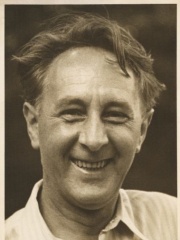
5. Bohuslav Martinů (1890 - 1959)
With an HPI of 73.98, Bohuslav Martinů is the 5th most famous Czech Composer. His biography has been translated into 43 different languages.
Bohuslav Jan Martinů (Czech: [ˈboɦuslaf ˈmarcɪnuː] ; December 8, 1890 – August 28, 1959) was a Czech composer of modern classical music. He wrote 6 symphonies, 15 operas, 14 ballet scores, and a large body of orchestral, chamber, vocal, and instrumental works. He became a violinist in the Czech Philharmonic Orchestra, and briefly studied under Czech composer and violinist Josef Suk. After leaving Czechoslovakia in 1923 for Paris, Martinů deliberately withdrew from the Romantic style in which he had been trained. During the 1920s he experimented with modern French stylistic developments, exemplified by his orchestral works Half-time and La Bagarre. He also adopted jazz idioms, for instance in his Kitchen Revue (Kuchyňská revue). In the early 1930s he found his main fount for compositional style: neoclassicism, creating textures far denser than those found in composers treating Stravinsky as a model. He was prolific, quickly composing chamber, orchestral, choral, and instrumental works. His Concerto Grosso and the Double Concerto for Two String Orchestras, Piano and Timpani are among his best-known works from this period. Among his operas, Juliette and The Greek Passion are considered the finest. He has been compared to Prokofiev and Bartók in his innovative incorporation of Czech folk elements into his music. He continued using Bohemian and Moravian folk melodies throughout his oeuvre, for instance in The Opening of the Springs (Otvírání studánek). His symphonic career began when he emigrated to the United States in 1941, fleeing the German invasion of France. His six symphonies were performed by all the major US orchestras. Martinů returned to live in Europe for two years starting in 1953, then was back in New York until returning to Europe in May 1956. He died in Switzerland in August 1959.

6. Jan Dismas Zelenka (1679 - 1745)
With an HPI of 69.88, Jan Dismas Zelenka is the 6th most famous Czech Composer. His biography has been translated into 31 different languages.
Jan Dismas Zelenka (16 October 1679 – 23 December 1745) was a Czech composer and musician of the Baroque period. His music is admired for its harmonic inventiveness and mastery of counterpoint. Zelenka was raised in Central Bohemia, educated in Prague and Vienna, and spent his professional life in Dresden. The greatest success during his career was the performance of the extensive composition Sub olea pacis et palma virtutis in the presence of the Emperor Charles VI, shortly after his coronation as king of Bohemia in 1723.

7. Johann Stamitz (1717 - 1757)
With an HPI of 69.81, Johann Stamitz is the 7th most famous Czech Composer. His biography has been translated into 36 different languages.
Johann Wenzel Anton Stamitz (Czech: Jan Václav Antonín Stamic; 18 June 1717 – 27 March 1757) was a Czech composer and violinist. Johann is considered the founding father of the Mannheim school, a composition style that his two surviving sons, Carl and Anton Stamitz, continued. His music is stylistically transitional between the Baroque and Classical periods and he is recognized for many innovations.

8. Josef Mysliveček (1737 - 1781)
With an HPI of 69.34, Josef Mysliveček is the 8th most famous Czech Composer. His biography has been translated into 28 different languages.
Josef Mysliveček (9 March 1737 – 4 February 1781) was a composer from Bohemia who contributed to the formation of late eighteenth-century classicism in music. Mysliveček provided his younger friend Wolfgang Amadeus Mozart with significant compositional models in the genres of symphony, Italian serious opera, and violin concerto; both Wolfgang and his father Leopold Mozart considered him an intimate friend from the time of their first meetings in Bologna in 1770 until he betrayed their trust over the promise of an operatic commission for Wolfgang to be arranged with the management of the Teatro San Carlo in Naples. His closeness to the Mozart family resulted in frequent references to him in the Mozart correspondence.

9. Erich Wolfgang Korngold (1897 - 1957)
With an HPI of 69.27, Erich Wolfgang Korngold is the 9th most famous Czech Composer. His biography has been translated into 38 different languages.
Erich Wolfgang Korngold (German: [ˈeːʁɪç ˈvɔlfɡaŋ ˈkɔʁnɡɔlt]; May 29, 1897 – November 29, 1957) was an Austrian composer and conductor, who left Europe in the mid-1930s and later adopted US nationality. A child prodigy, he became one of the most important and influential composers in Hollywood history. He was a noted pianist and composer of classical music, along with music for Hollywood films, and the first composer of international stature to write Hollywood scores. When he was 11, his ballet Der Schneemann (The Snowman) became a sensation in Vienna; his Second Piano Sonata, which he wrote at age 13, was played throughout Europe by Artur Schnabel. His one-act operas Violanta and Der Ring des Polykrates were premiered in Munich in 1916, conducted by Bruno Walter. At 23, his opera Die tote Stadt (The Dead City) premiered in Hamburg and Cologne. In 1921 he conducted the Hamburg Opera. During the 1920s he re-orchestrated, re-arranged and nearly re-composed several operettas by Johann Strauss II. By 1931 he was a professor of music at the Vienna State Academy. At the request of motion picture director Max Reinhardt, and due to the rise of the Nazi regime, Korngold moved to Hollywood in 1934 to write music for films. His first was Reinhardt's A Midsummer Night's Dream (1935). He subsequently wrote scores for such films as Captain Blood (1935), which helped boost the career of its starring newcomer, Errol Flynn. His score for Anthony Adverse (1936) won an Oscar; two years later he won another Oscar for The Adventures of Robin Hood (1938). Korngold scored 16 Hollywood films in all, and received two more nominations for Oscars. Along with Max Steiner and Alfred Newman, he is one of the founders of American film music. Although his late-Romantic style of classical composition was no longer as popular when he died in 1957, his music underwent a resurgence of interest in the 1970s beginning with the release of the RCA Red Seal album The Sea Hawk: The Classic Film Scores of Erich Wolfgang Korngold (1972). This album, produced by his son George Korngold, was hugely popular and ignited interest in his other film music (and that of other classic film composers), as well as in his concert music, which often incorporates popular themes from his film scores (an example being the Violin Concerto in D, Op. 35, which incorporates themes from four of his motion picture scores and has become part of the standard repertoire).
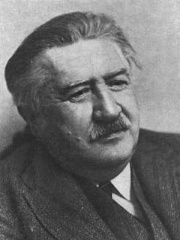
10. Josef Suk (1874 - 1935)
With an HPI of 69.26, Josef Suk is the 10th most famous Czech Composer. His biography has been translated into 37 different languages.
Josef Suk (4 January 1874 – 29 May 1935) was a Czech composer, violinist, and Olympic silver medalist. He studied under Antonín Dvořák, whose daughter he married.
People
Pantheon has 60 people classified as Czech composers born between 1567 and 1959. Of these 60, 1 (1.67%) of them are still alive today. The most famous living Czech composers include Vladimír Franz. The most famous deceased Czech composers include Gustav Mahler, Antonín Dvořák, and Bedřich Smetana.
Living Czech Composers
Go to all RankingsDeceased Czech Composers
Go to all RankingsGustav Mahler
1860 - 1911
HPI: 87.34
Antonín Dvořák
1841 - 1904
HPI: 85.64
Bedřich Smetana
1824 - 1884
HPI: 82.59
Leoš Janáček
1854 - 1928
HPI: 76.24
Bohuslav Martinů
1890 - 1959
HPI: 73.98
Jan Dismas Zelenka
1679 - 1745
HPI: 69.88
Johann Stamitz
1717 - 1757
HPI: 69.81
Josef Mysliveček
1737 - 1781
HPI: 69.34
Erich Wolfgang Korngold
1897 - 1957
HPI: 69.27
Josef Suk
1874 - 1935
HPI: 69.26
Anton Reicha
1770 - 1836
HPI: 67.87
Eduard Hanslick
1825 - 1904
HPI: 67.73
Overlapping Lives
Which Composers were alive at the same time? This visualization shows the lifespans of the 25 most globally memorable Composers since 1700.


